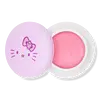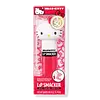What's inside
What's inside
 Key Ingredients
Key Ingredients

 Benefits
Benefits

 Concerns
Concerns

 Ingredients Side-by-side
Ingredients Side-by-side

Hydrogenated Polyisobutene
EmollientBeeswax
Emulsion StabilisingEthylhexyl Palmitate
EmollientOlea Europaea Fruit Oil
MaskingMacadamia Integrifolia Seed Oil
Skin ConditioningButyrospermum Parkii Butter
Skin ConditioningTrihydroxystearin
Skin ConditioningHelianthus Annuus Seed Oil
EmollientDiisostearyl Malate
EmollientEthylene/Propylene/Styrene Copolymer
Tocopheryl Acetate
AntioxidantPolyglyceryl-2 Triisostearate
EmulsifyingMangifera Indica Seed Butter
Skin ConditioningCaprylic/Capric Triglyceride
MaskingButylene/Ethylene/Styrene Copolymer
1,2-Hexanediol
Skin ConditioningBHT
AntioxidantParfum
MaskingCI 77891
Cosmetic ColorantCI 77499
Cosmetic ColorantCI 77742
Cosmetic ColorantCI 15850
Cosmetic ColorantCI 42090
Cosmetic ColorantCI 19140
Cosmetic ColorantCI 15985
Cosmetic ColorantCI 45410
Cosmetic ColorantHydrogenated Polyisobutene, Beeswax, Ethylhexyl Palmitate, Olea Europaea Fruit Oil, Macadamia Integrifolia Seed Oil, Butyrospermum Parkii Butter, Trihydroxystearin, Helianthus Annuus Seed Oil, Diisostearyl Malate, Ethylene/Propylene/Styrene Copolymer, Tocopheryl Acetate, Polyglyceryl-2 Triisostearate, Mangifera Indica Seed Butter, Caprylic/Capric Triglyceride, Butylene/Ethylene/Styrene Copolymer, 1,2-Hexanediol, BHT, Parfum, CI 77891, CI 77499, CI 77742, CI 15850, CI 42090, CI 19140, CI 15985, CI 45410
Ricinus Communis Seed Oil
MaskingCaprylic/Capric Triglyceride
MaskingBeeswax
Emulsion StabilisingEuphorbia Cerifera Wax
Polybutene
Ethylhexyl Palmitate
EmollientHelianthus Annuus Hybrid Oil
EmollientParaffin
PerfumingAroma
Copernicia Cerifera Wax
Hydrogenated Soybean Oil
EmollientTocopheryl Acetate
AntioxidantSorbic Acid
PreservativeTocopherol
AntioxidantTridecyl Trimellitate
EmollientMicrocrystalline Wax
Emulsion StabilisingPentaerythrityl Stearate/Caprate/Caprylate/Adipate
EmollientStearic Acid
CleansingSucralose
Skin ConditioningPhenoxyethanol
PreservativeGlycine Soja Oil
EmollientCI 77499
Cosmetic ColorantCI 15850
Cosmetic ColorantCI 19140
Cosmetic ColorantRicinus Communis Seed Oil, Caprylic/Capric Triglyceride, Beeswax, Euphorbia Cerifera Wax, Polybutene, Ethylhexyl Palmitate, Helianthus Annuus Hybrid Oil, Paraffin, Aroma, Copernicia Cerifera Wax, Hydrogenated Soybean Oil, Tocopheryl Acetate, Sorbic Acid, Tocopherol, Tridecyl Trimellitate, Microcrystalline Wax, Pentaerythrityl Stearate/Caprate/Caprylate/Adipate, Stearic Acid, Sucralose, Phenoxyethanol, Glycine Soja Oil, CI 77499, CI 15850, CI 19140
Ingredients Explained
These ingredients are found in both products.
Ingredients higher up in an ingredient list are typically present in a larger amount.
Beeswax is natural wax produced by honey bees and can be synthetically created. It consists mainly of fatty acid esters and long-chain alcohols.
In cosmetics, beeswax is a emollient. Due to its waxy structure, it creates a protective barrier. This barrier prevents water from evaporating off the skin.
This may not be a good ingredient for oily skin. We recommend speaking with a professional if you have concerns.
Beeswax cannot be removed with water, but can be taken off with an oil cleanser.
Beeswax is also antiseptic and contains vitamin A.
Learn more about BeeswaxThis ingredient is an emollient, solvent, and texture enhancer. It is considered a skin-softener by helping the skin prevent moisture loss.
It helps thicken a product's formula and makes it easier to spread by dissolving clumping compounds.
Caprylic Triglyceride is made by combining glycerin with coconut oil, forming a clear liquid.
While there is an assumption Caprylic Triglyceride can clog pores due to it being derived from coconut oil, there is no research supporting this.
Learn more about Caprylic/Capric TriglycerideCi 15850 is the pigment color red. It is an azo dye and created synthetically.
Azo dyes need to be thoroughly purified before use. This allows them to be more stable and longer-lasting.
This ingredient is common in foundations, lipsticks, and blushes. This color is described as brown/orangey red.
It has many secondary names such as Red 6 and Red 7. According to a manufacturer, Red 6 usually contains aluminum.
Learn more about CI 15850CI 19140 is also known as Tartrazine. Tartrazine is a synthetic dye used in cosmetics, foods, and medicine to add a yellow color.
Tartrazine is created from petroleum and is water-soluble.
Some people may experience allergies from this dye, especially asthmatics and those with an aspirin intolerance.
Learn more about CI 19140Ci 77499 is also hydrated iron III oxide. It is created from mixing red and black iron oxides. This helps give shades of darkness to a product.
Iron III oxides are classified as inorganic chemicals for coloring.
Ethylhexyl Palmitate, also known as octyl palmitate, is created from 2-ethylhexyl alcohol and palmitic acid. It is a fatty acid ester.
The fatty acid content of Ethylhexyl Palmitate makes it an emollient. Emollients help soften and hydrate your skin by trapping moisture within.
Ethylhexyl Palmitate is also used to help improve the texture of cosmetics. It helps other ingredient dissolve in products and help disperse ingredients more evenly.
You'll likely find this ingredient in sunscreen, as it is often used to mix UV-blocking ingredients such as avobenzone and ethylhexyl triazone.
It can also help stabilize the fragrances in a product as a fragrance fixative.
Ethylhexyl Palmitate can be used to substitute mineral oil.
Due to its high fatty acid content, it may not be fungal-acne safe.
Learn more about Ethylhexyl PalmitateTocopheryl Acetate is AKA Vitamin E. It is an antioxidant and protects your skin from free radicals. Free radicals damage the skin by breaking down collagen.
One study found using Tocopheryl Acetate with Vitamin C decreased the number of sunburned cells.
Tocopheryl Acetate is commonly found in both skincare and dietary supplements.
Learn more about Tocopheryl Acetate